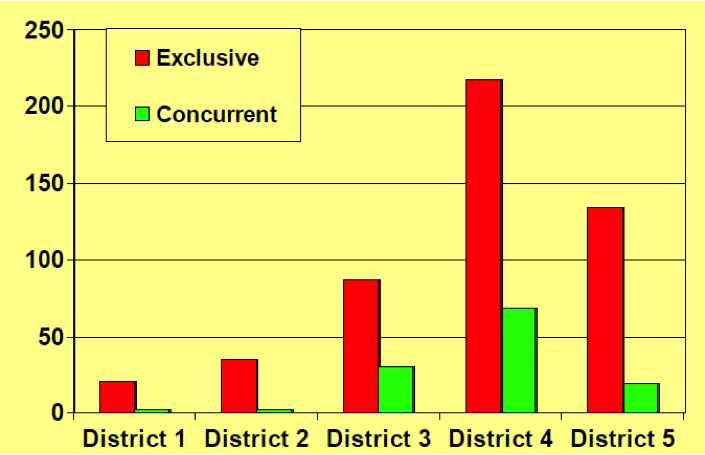
Technical Memorandum
DATE: June 4, 2015
TO: Boston Region Metropolitan Planning Organization (MPO)
FROM: Seth Asante and Andrew Nagle, MPO Staff
RE: Pedestrian Signal Phasing Study
This memorandum summarizes a review of the literature on existing practices and guidelines for pedestrian signal phasing and the results of an MPO survey about municipal pedestrian signal phasing. Based on the literature review and survey, MPO staff recommends measures to improve pedestrian safety at signalized intersections.
Pedestrian signals provide indications intended exclusively to control pedestrian traffic at signalized intersections. Pedestrian signals are incorporated into the overall traffic signal cycle and can operate as an exclusive or concurrent pedestrian phase. Exclusive pedestrian phasing allows pedestrians to cross the intersection in all directions while vehicular traffic is stopped. This phasing type is typically favored for pedestrian safety, but it forces pedestrians to wait through an entire cycle of traffic before crossing is permitted. Concurrent pedestrian phasing allows pedestrians to cross simultaneously with parallel traffic and can therefore reduce pedestrian delay, but conflicts may arise between pedestrians and turning vehicles.
Because of safety and operational impacts, pedestrian signal phase type must be selected to maximize safety benefits and maintain efficient traffic flow. The selection of pedestrian signal phase type involves several complicated factors and often poses challenges to municipalities. Currently, very little guidance exists to help municipalities identify appropriate pedestrian signal phase type at intersections. Also, municipalities may not be aware of advances in technology producing new devices and methods to enhance pedestrian safety at intersections.
The objective of the study is to identify the conditions under which each type of pedestrian phasing is appropriate. Municipalities in the MPO region can then apply this guidance to develop policies for pedestrian signals and phasing when redesigning signalized intersections. Another objective of the study is to determine state-of-the-art practices for applying exclusive or concurrent pedestrian signal phasing.
The following sections describe the operations and factors that distinguish the two pedestrian signal-phasing methods.
An exclusive pedestrian phase is a portion of a traffic signal cycle that is reserved for pedestrian movements while displaying red on all traffic signals for vehicles. Exclusive phasing is most often considered for intersections in downtown areas or central business districts with high pedestrian volumes. Exclusive phasing is also considered for intersections with excessive pedestrian-vehicle conflicts caused by factors such as limited sight distance, road geometry, and high traffic volumes. Assuming perfect compliance, exclusive signal phasing eliminates pedestrian-vehicle conflicts during the pedestrian phase.
The decision to implement an exclusive pedestrian phasing as part of a pedestrian solution must be weighed against its impact on traffic as a whole. To add an exclusive pedestrian phase to the overall traffic signal cycle, either the cycle length must be lengthened or other phase lengths in the signal cycle must be shortened. In either case, incorporating an exclusive phase for pedestrians significantly decreases the intersection’s capacity and increases delays for motorized vehicles. Similarly, an exclusive pedestrian phase increases pedestrian delays and the potential for pedestrian violations during the do-not-walk interval.
For exclusive pedestrian phasing to be employed properly, clear and appropriate audible cues must be provided for the visually impaired. This helps pedestrians with disabilities to navigate the crossings and avoid vehicular conflicts.1 Several studies have proposed thresholds where exclusive phasing can effectively improve pedestrian safety. Zegeer et al. found that exclusive pedestrian phasing, compared with concurrent signal phasing or none at all, yields measurable reductions in collisions only when pedestrian volume exceeds 1,200 persons per day.2 Tian et al. created a pedestrian phasing model which indicated that exclusive phasing is appropriate for intersections where the time ratio of combined through-traffic phases to pedestrian phases is lower than 0.5. The model also suggested that concurrent phasing is appropriate for intersections when the ratio is larger than 1.5. Conditions between 0.5 and 1.5 would require additional investigation based on vehicle and pedestrian volumes and other factors.3 For more localized guidance, the Boston Complete Streets Guidelines suggest that exclusive phasing should be implemented in the City of Boston when: 4
Concurrent phasing allows pedestrians and nonconflicting traffic to move simultaneously at a signalized intersection. This typically improves vehicular operations by shortening the cycle length and also reduces waiting time for both vehicles and pedestrians. The chief disadvantage of concurrent phasing is the potential conflict between pedestrians and turning vehicles. Signal phasing solutions such as a leading pedestrian interval, protected left-turn phasing, and turning restrictions, when implemented appropriately, can increase pedestrian safety and traffic efficiency.
An LPI begins the walk signal about 3 to 6 seconds before the concurrent vehicle phase.5 Thus, pedestrians get a head start in crossing and are more visible to turning vehicles, which are then more likely to yield. An LPI may be appropriate if a high percentage of pedestrian crossings are compromised by having to yield to turning vehicles. As a means of reducing pedestrian-vehicle crashes, an LPI is also a relatively low-cost solution.
Signal phasing for left and right turns has a major impact on pedestrian activity at signalized intersections. There are two major signal-phasing operations for turning vehicles: protected and permissive. Protected phasing provides turning vehicles the right-of-way, indicated by a green arrow on a signal head. Under permissive phasing, turning vehicles must yield to oncoming traffic and pedestrians.
Traditionally, the factors to determine which phasing to use is based on number of crashes, sight distance, crossing distance, number of through lanes and turning lanes, volume of through traffic and turning traffic, speed limit, and turning delay.6 Protected phasing benefits the specified turning movements and reduces pedestrian-vehicle conflicts but potentially increases intersection delays. Permissive phasing provides the most efficient signal cycle and vehicular operations but may increase pedestrian-vehicle conflicts. Most studies of protected versus permissive turning focus on left turns, because those generate more conflicts than right turns.7 Left-turning drivers also spend more time than right-turning drivers looking out for obstructions.8 Right turns are usually permissive unless noted otherwise.
Concurrent pedestrian phasing is preferred if there is a protected left-turn phase because of a large number of left-turning vehicles. This typically results in higher pedestrian compliance and limits pedestrian-vehicle conflicts to right-turning vehicles only. However, concurrent pedestrian phasing is also preferred with a permissive left-turn phase if there is a light-to-moderate amount of left- and right-turn volumes and adequate sight distance. In such a case, pedestrian-vehicle conflicts can arise for both left- and right-turning vehicles.
Right-turn-on-red (RTOR) restrictions prohibit vehicles from turning right while the traffic signal indication is red. RTOR restrictions are implemented using low-cost static or dynamic signage at the intersection such as no-turn-on-red signs. With recent advancements in technologies, RTOR restrictions are possible using dynamic LED signs, which allow the RTOR prohibition to be triggered by a pedestrian pushing the button for the pedestrian signal. Instead of relying on peak-hour or time-of-day restrictions to reduce vehicle-pedestrian conflicts, this method provides real-time restrictions based on pedestrian demand.9
RTOR restrictions are usually considered when exclusive pedestrian phases or high pedestrian volumes are present. RTOR restrictions with an exclusive pedestrian phase eliminate vehicle-pedestrian collisions. RTOR restrictions are also beneficial with concurrent pedestrian phasing, especially when it is supplemented with an LPI. Prohibiting RTOR along with an LPI provides pedestrian benefits with minimal impacts to motorized traffic. Part-time RTOR restrictions during peak hours also provide similar benefits while removing the prohibition when pedestrian or vehicular traffic is low.
Table 1 presents the benefits and concerns of the two phase types and factors that affect their selection.
TABLE 1
Comparison of Exclusive and Concurrent Pedestrian Phasing
| Exclusive Pedestrian Phase |
Concurrent Pedestrian Phase |
|---|---|
Conflicts |
Conflicts |
Feeling of security for all pedestrians when there are no vehicle conflicts |
Conflict between turning vehicles and pedestrians |
Delay |
Delay |
Longer delays for motor vehicles and pedestrians |
Fewer delays for motor vehicles and pedestrians |
Compliance |
Compliance |
Less compliance: pedestrians often cross against the traffic light concurrent with parallel traffic if no conflicts are apparent. |
High compliance: incorporation of LPI lessens conflict with turning vehicles. |
User judgment |
User judgment |
May require no-right-turn-on-red sign to operate effectively |
Pedestrians must exercise more caution and judgment; incorporation of LPI lessens conflict with turning vehicles. |
Conditions for application |
Conditions for application |
· High pedestrian volume |
· Low to moderate pedestrian volume |
· Pedestrian flow > 1200 persons per day |
· Pedestrian flow ≤ 1200 persons per day |
· Conflicting turning vehicles ≥ 250 vehicle/hour |
· Conflicting turning vehicles ≤ 250 vehicle/hour |
· Signalized intersections with high concentrations of older pedestrians, students, disabled (not visually impaired), or very young pedestrians |
· Signalized intersections with low concentrations of older pedestrians, students, or very young pedestrians |
· Complex intersections with poor sight distance |
· Simple intersections with good sight distance |
|
· Short crosswalks < 55 feet |
Accessibility |
Accessibility |
It is a disadvantage for pedestrians with disabilities who rely on traffic sounds to determine the signal phases. In addition, initial alignment and maintaining alignment during crossings may be difficult due to the absence of parallel moving traffic. APS may address some of these issues |
It is an advantage for pedestrians with disabilities who rely on traffic sounds to determine the signal phases. In addition, initial alignment and maintaining alignment during crossings may be difficult due to the absence of parallel moving traffic. |
Pedestrian convenience |
Pedestrian convenience |
Pedestrian crossings may be made diagonally for pedestrian efficiency but will increase delay for drivers. |
Pedestrian crossing is always parallel to the nonconflicting through movements of drivers. |
Statewide and regional pedestrian policies are an important means of reducing user confusion and providing consistency throughout the state’s transportation network. Such policies establish the approval process for selecting, installing, modifying, and removing pedestrian traffic signals. In addition, statewide pedestrian signal policy promotes consistent practices across municipalities, which increases pedestrian understanding and compliance with pedestrian signals. The following are the pedestrian signal policies of the six New England states; they show no clear preference among the states for a particular phase type.10
The Figures 1A and 1B shows the distribution of exclusive and concurrent pedestrian signal phasing in MassDOT-owned traffic signal systems, separated by Highway Division district. Preference for exclusive pedestrian phasing is well established. Highway districts in Eastern Massachusetts, especially District 4 and District 5 (part of which was reorganized into District 6), appear to have significant proportions of concurrent pedestrian signal phasing.
FIGURE 1A
MassDOT Traffic Signal Pedestrian Phase Types

FIGURE 1B
MassDOT Highway Districts

A survey created by MPO staff has been used to collect information from selected municipalities throughout the MPO area. The purpose was to investigate existing pedestrian signal policies and guidelines and what insight they can provide on selecting and operating pedestrian signals. City and town engineers and public-works directors from 35 municipalities were solicited; 14 municipalities completed the survey.
The selection was designed to include municipalities of each of the following types:
The survey questionnaire was divided into four parts: 1) general information about the town or city, 2) pedestrian signal policy, 3) pedestrian signal phasing selection criteria, and 4) methods to enhance pedestrian signal phasing. The survey was distributed to municipalities in June 2014. MPO staff allowed two weeks and an extra one-week reminder for municipalities to respond. A map of the 35 municipalities selected to participate in the survey and the 14 municipalities that responded to the survey is shown in Figure 2. The full survey is provided in Appendix A and the responses in Appendix B.
FIGURE 2
Municipal Pedestrian Signal Phasing Survey
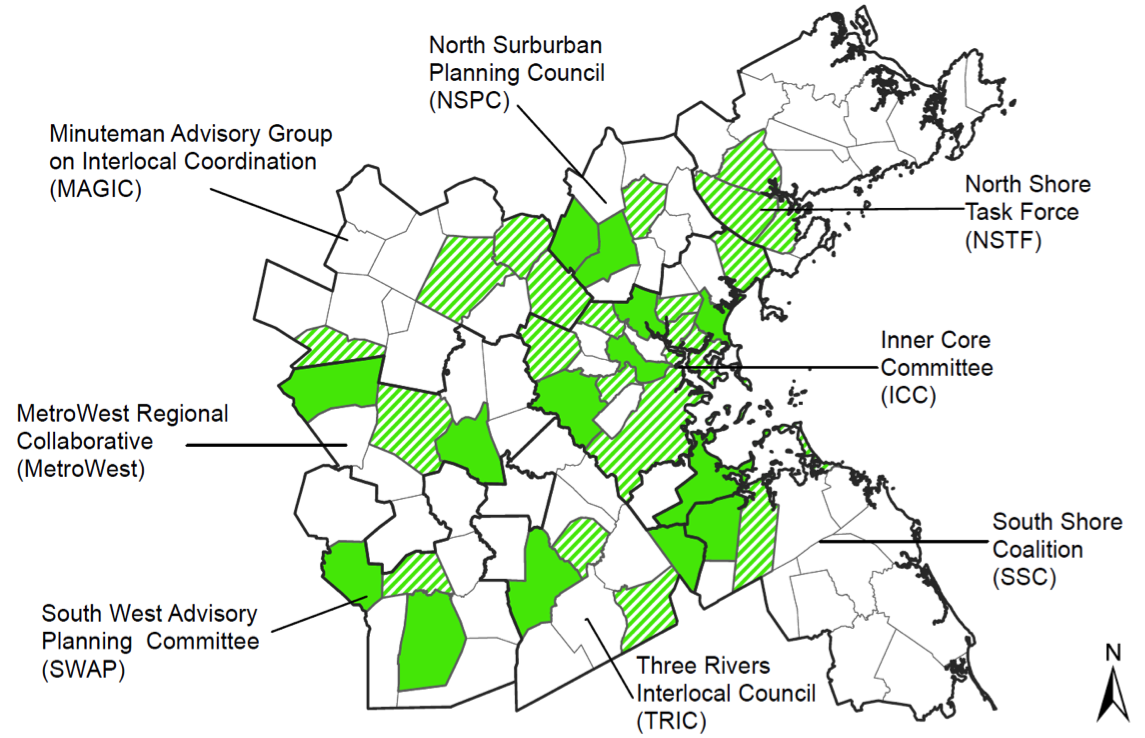 5.2 Analysis and Results of Survey
5.2 Analysis and Results of Survey
Part II, Questions 3 through 5 of the survey explored how municipalities decide whether to use concurrent or exclusive pedestrian signal phasing. The aim was to determine if municipalities have established policies for the selection process and how those policies might change.
Figure 3
Written Policy
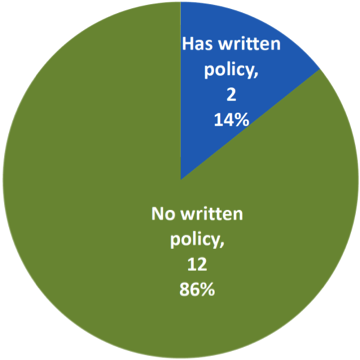
Figure 4
Future Policy Changes
Figure 5
Preference
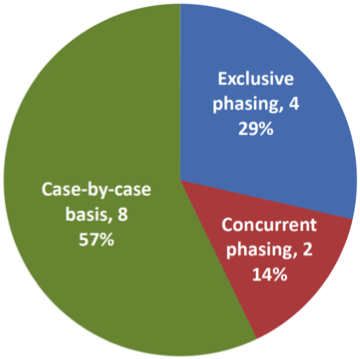
Part of the survey focused on criteria for selecting pedestrian signal-phasing (Questions 6 and 7). The aim was to identify the selection criteria and how uniformly they were used. The questions permitted selecting multiple answers; therefore, the total number of responses exceeds the number of municipalities.
municipalities.
Figure 6
Selection Criteria:
Exclusive Pedestrian Signal Phasing
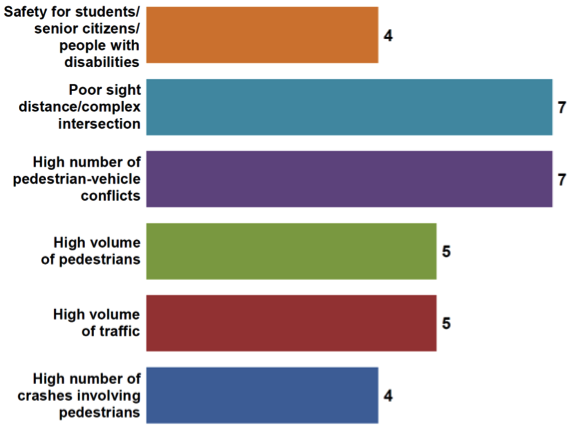
Figure 7
Selection Criteria:
Concurrent Pedestrian Signal Phasing
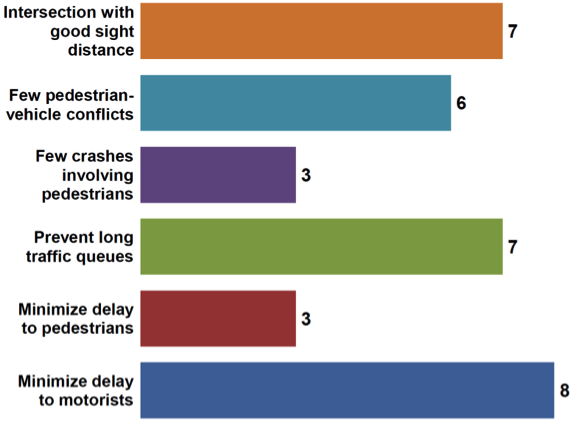
Part IV of the survey examined how municipalities enhance their existing pedestrian signal phases (Questions 8 through 10). The aims were to determine typical complaints municipalities receive from their citizens, methods that municipalities are using to improve safety performance of pedestrian signal phasings, and the process that is followed to change an existing pedestrian signal phasing. Multiple answers were allowed for these questions; therefore, the total number of responses exceeds the number of municipalities.
Complaints from citizens about pedestrian signal phasing are very common, and they receive high attention from municipal traffic engineers, planners, and elected officials (Figure 8).
Figure 8
Typical Complaints from Citizens
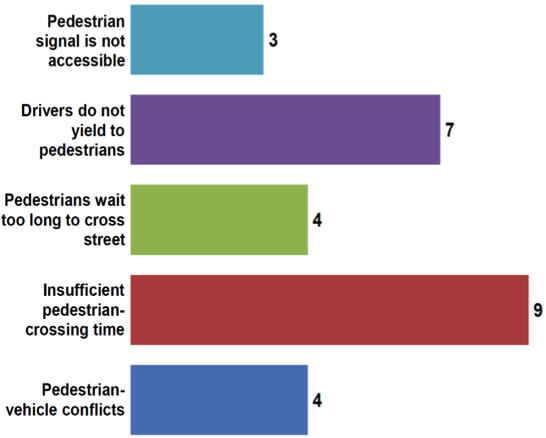
Several methods are available to increase the safety and efficiency of pedestrian signal phase types, and they are receiving growing attention from many municipalities (Figure 9).
Figure 9
Safety Enhancements
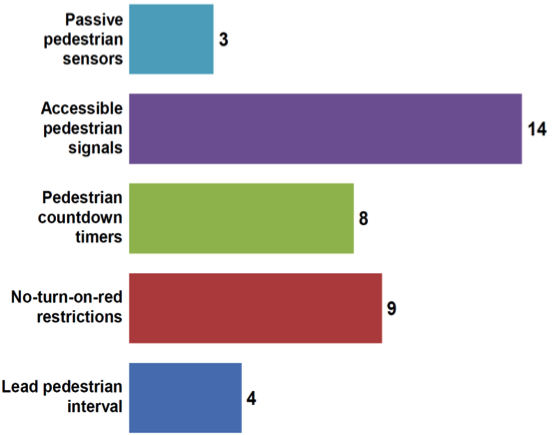
Although conversion of pedestrian signal phase type is infrequent, the decision to change existing pedestrian signal phasing can evolve from several sources of input (Figure 10).
Figure 10
Converting Pedestrian Signal Phasings
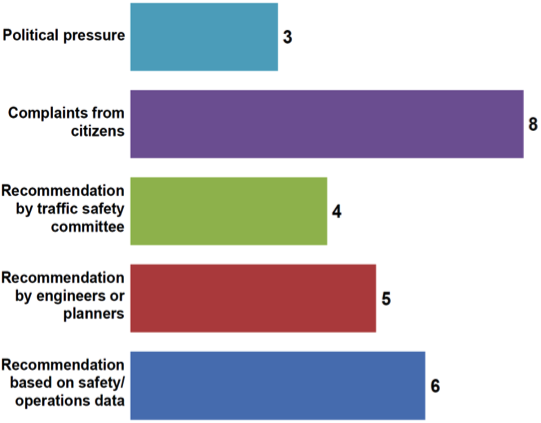
Six municipalities were selected for evaluation of their practices, challenges, and recommendations for improvements: Braintree, Cambridge, Franklin, Marlborough, Newton, and Woburn. Inputs from these municipalities were also used in the findings and recommendations of this study. They include how they are impacted by the lack of:
As part of the case studies, MPO staff wanted to identify as many as four intersections where conversions from exclusive to concurrent pedestrian phasing or vice versa took place to conduct before-and-after safety evaluations. This objective was not met because of low sample sizes—few intersections had experienced more than a few pedestrian crashes over a three-year period. Thus, a before-and-after study would likely have no statistical significance. In general, because reported pedestrian crashes are rare events, the large sample sizes required to study them would be beyond the means of this study.
Based on a review of the literature, the municipal survey, and case studies, MPO staff have made the following findings, recommendations, and conclusions:
There appears to be a need for a statewide or regional policy recommendation to provide direction for implementing safe and efficient pedestrian phasing and provide the needed support to adopt a local policy. The lack of written policies hinders efforts to select appropriate pedestrian signal phasing based on site conditions. Some municipalities primarily use exclusive pedestrian signal phasing and do not consider concurrent pedestrian phasing, even in cases where it might increase pedestrian safety and efficiency.
Pedestrian and driver education on how concurrent and exclusive pedestrian phasing work and their benefits are needed—many people perceive concurrent phasing as unsafe. Feedback from the survey indicated instances where concurrent pedestrian signal phasing that seemed to be functioning well was switched back to exclusive phasing because of neighborhood complaints or the impression that they were unsafe. Road users need a better understanding of the operations of exclusive and concurrent pedestrian signal phasings to reduce the potential for driver confusion and pedestrian-vehicle conflicts. Education campaigns to raise road users' awareness are also very much needed. Such education will require coordination between MassDOT Highway Division, MassDOT Registry of Motor Vehicles, and the municipalities to identify the appropriate media and content for the education campaigns.
A warrant is an engineering study of traffic conditions, pedestrian characteristics, and physical characteristics of the location performed to determine whether a concurrent or exclusive pedestrian signal phasing is justified at a particular location. Neither mode of pedestrian signal phasing works for all locations. Therefore, warrants for selecting pedestrian signal phasing type, similar to the traffic-signal warrants used to justify the installation of traffic signals, would be useful. Concurrent pedestrian signal phasing with an LPI works well when it is prevalent throughout an area and pedestrians are familiar with and understand its operations. It also works well at locations where there is the need to balance pedestrian safety with efficient traffic operations. Exclusive pedestrian phasing, when supplemented with RTOR restrictions, works well at locations with high pedestrian-vehicle conflicts or a high number of students or elderly people and at complex intersections with poor sight distance.
Many municipalities are upgrading their signal equipment to improve safety, accessibility, and operations. New technologies to improve the safety of pedestrian signal phasing include LPI, countdown timers, APS, pedestrian sensors (video and infrared), and dynamic signs.
This system, upon detecting a pedestrian either by push button or passive sensors, activates a no-turn-on-red LED sign or a red right-turn arrow signal to eliminate the conflict between a right-turning vehicle and a crossing pedestrian (Figure 11). This system can be programmed to activate at certain times of the day and be turned off at other times. It can also be combined with exclusive pedestrian phasing by prohibiting vehicles from turning right across crosswalks during the pedestrian phase.
Figure 11
Dynamic Signs
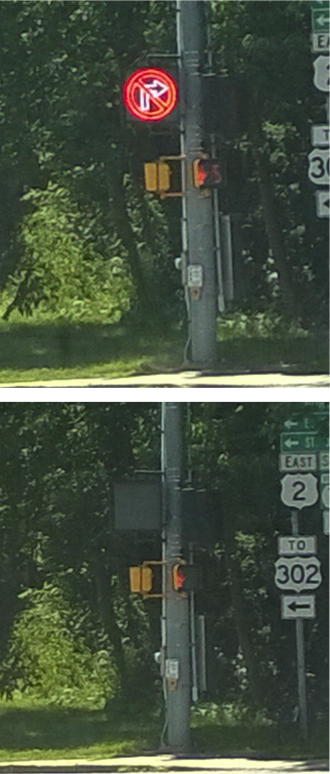
Benefits: At signalized intersections where significant conflicts exist with vehicles turning right across active crosswalks, pedestrian activation of a no-turn-on-red LED sign can eliminate the conflict. The concept of restricting right turns across active pedestrian crosswalks can be extended to prohibit left-turning vehicles across active pedestrian crosswalks.
Concerns: If pedestrian activation occurs throughout the pedestrian phase, vehicles will have no time to turn right. This could have a negative impact on traffic flow. An assessment is needed to determine the impact of a no-turn-on-red sign on traffic flow—such assessment should examine the congestion implications for vehicles traveling through the intersection as well as for vehicles turning right at the intersection.
This system uses passive sensors to detect pedestrians who enter the crosswalk at the end of the pedestrian walk interval and extends the interval long enough for the pedestrian to finish crossing. In addition, the system can cancel the call for the pedestrian signal if the pedestrian leaves the area. This feature can help prevent congestion caused by extended walk-signal times. Although automatic detection and extension of the walk signal for pedestrians is still in the early-deployment stage in the United States, the system has been used successfully in Europe and Australia for many years.
Benefits: This system may be particularly beneficial at signalized intersections where there is a wide range of walking speeds among pedestrians, such as those with concentrations of older pedestrians, disabled pedestrians, or very young pedestrians.
Concerns: In coordinated systems, signal coordination is more difficult to achieve, and in congested urban areas with heavy pedestrian traffic, a constant flow of pedestrians activating extended walk phases may contribute to congestion.
This study provides information about current practices for implementing concurrent and exclusive pedestrian signal phasing. The information, gathered from a review of the literature and the MPO’s survey, is useful to municipal engineers and planners in the MPO area for selecting appropriate pedestrian signal phase type and enhancements to maximize safety and efficiency for pedestrians and motorists. The study is also useful to the MPO and MassDOT by identifying needed actions:
SAA/ASN
1 National Cooperative Highway Research Program, Web-Only Document 150: Accessible Pedestrian Signals: A Guide to Best Practices (Workshop Edition 2010), Contractor’s Guide for NCHRP Project 3-62A, Submitted November 2009
2 Charles V. Zegeer et al., “Effect of Pedestrian Signals and Signal Timing on Pedestrian Accidents,” Transportation Research Record: Journal of the Transportation Research Board No. 847 (1982): 62-72.
3 Tian et al., “Pedestrian Timing Alternatives and Impacts on Coordinated Signal Systems Under Split-Phasing Operations,” Transportation Research Record: Journal of the Transportation Research Board No.1748 (2001): 46-54.
4 “Boston Complete Streets Guidelines Chapter 4: Intersection, Exclusive vs. Concurrent Phasing,” Boston Transportation Department, accessed March 26, 2014, http://issuu.com/bostontransportationdepartment/docs/4_9.
5 “Pedestrian Signals,” Pedestrian and Bicycle Information Center, accessed March 26, 2014, http://www.pedbikeinfo.org/planning/facilities_crossings_pedsignals.cfm.
6 “Traffic Signal Timing Manual Chapter 4: Traffic Signal Design,” USDOT, accessed March 26, 2014, http://ops.fhwa.dot.gov/publications/fhwahop08024/chapter4.htm.
7 Nicolas J. Garber and Raghavan Srinivasan, “Characteristics of Accidents Involving Elderly Drivers at Intersections,” Transportation Research Record: Journal of the Transportation Research Board No.1325 (1991): 8-16.
8 Heikki Summala et al., “Bicycle Accidents and Drivers’ Visual Search at Left and Right Turns, Accident Analysis & Prevention Vol.28, No. 2 (1996): 147-153.
9 Innovative Intersection Safety Improvement Strategies and Management Practices: A Domestic Scan, Chapter 3 Traffic Control Devices for Motorists, Federal Highway Administration, United States Department of Transportation, September 2006
10 A presentation to the New England Chapter of the Institute of Transportation Engineers